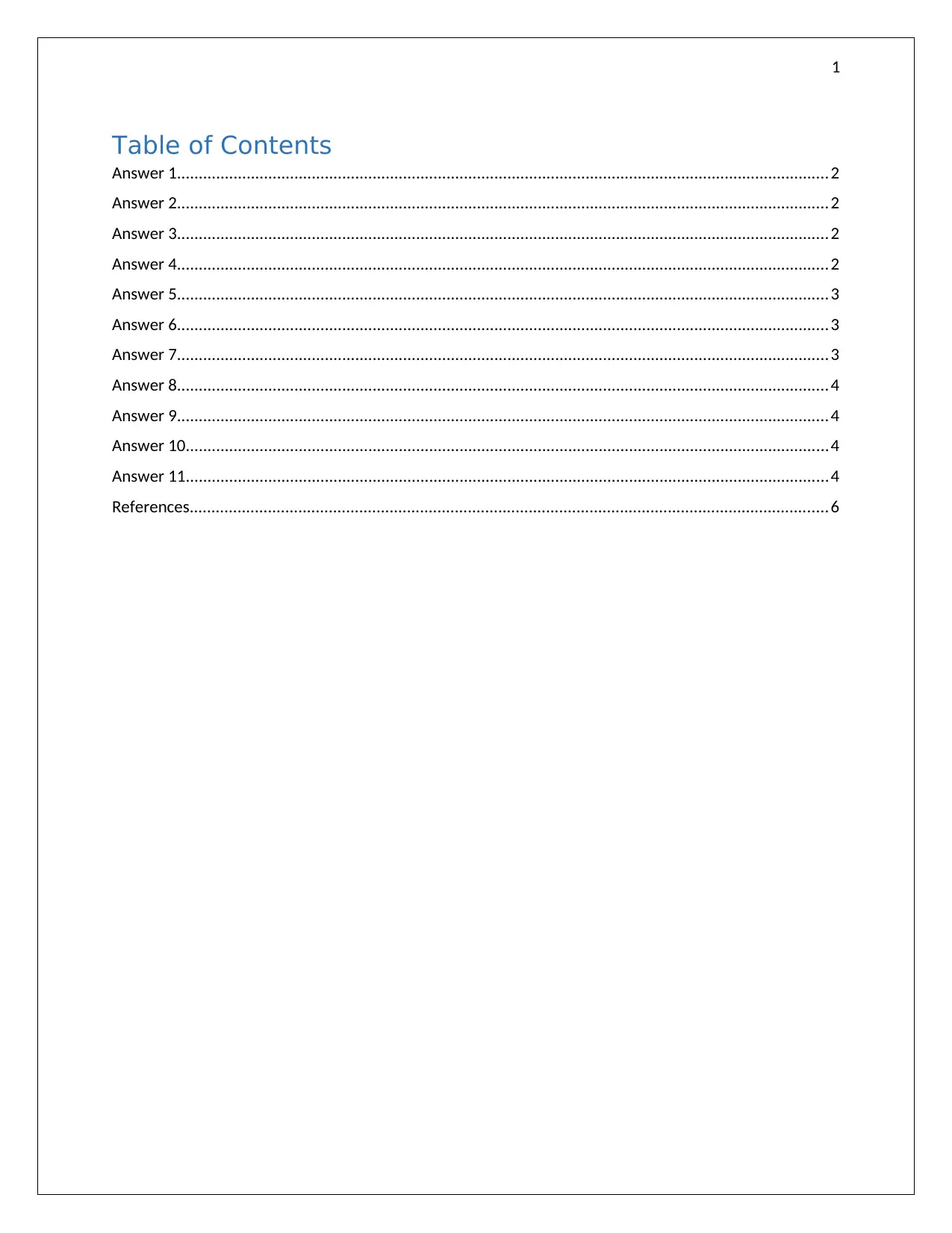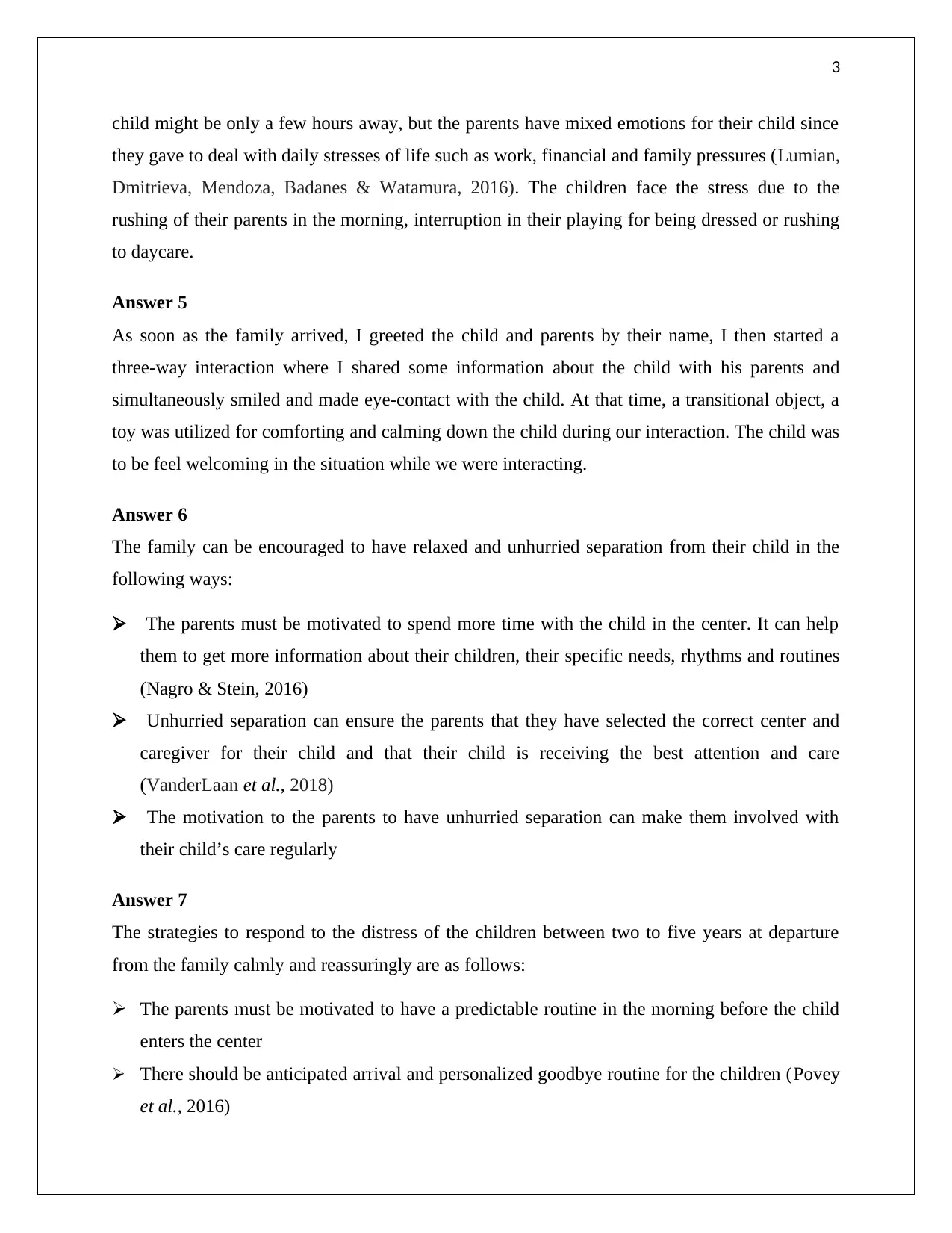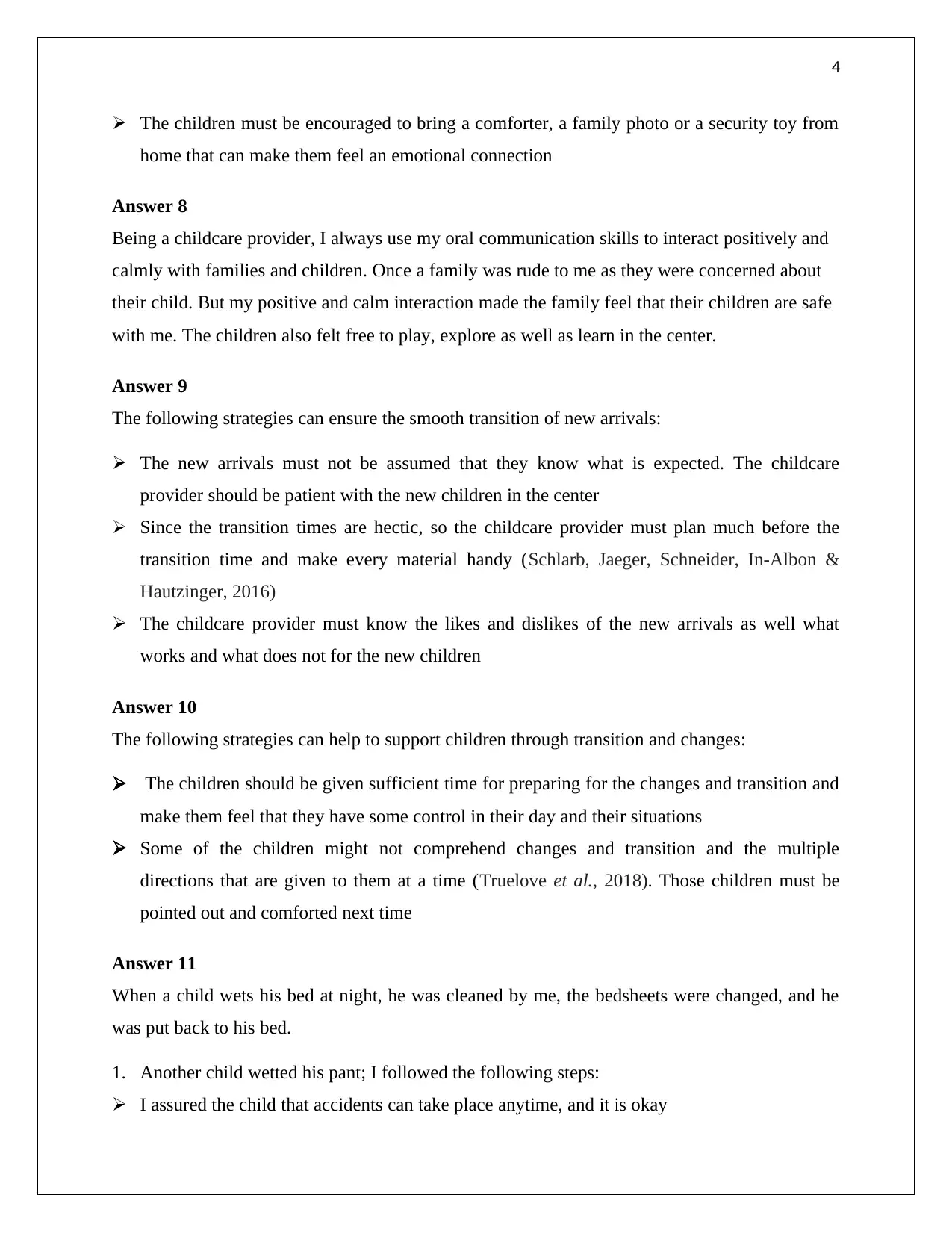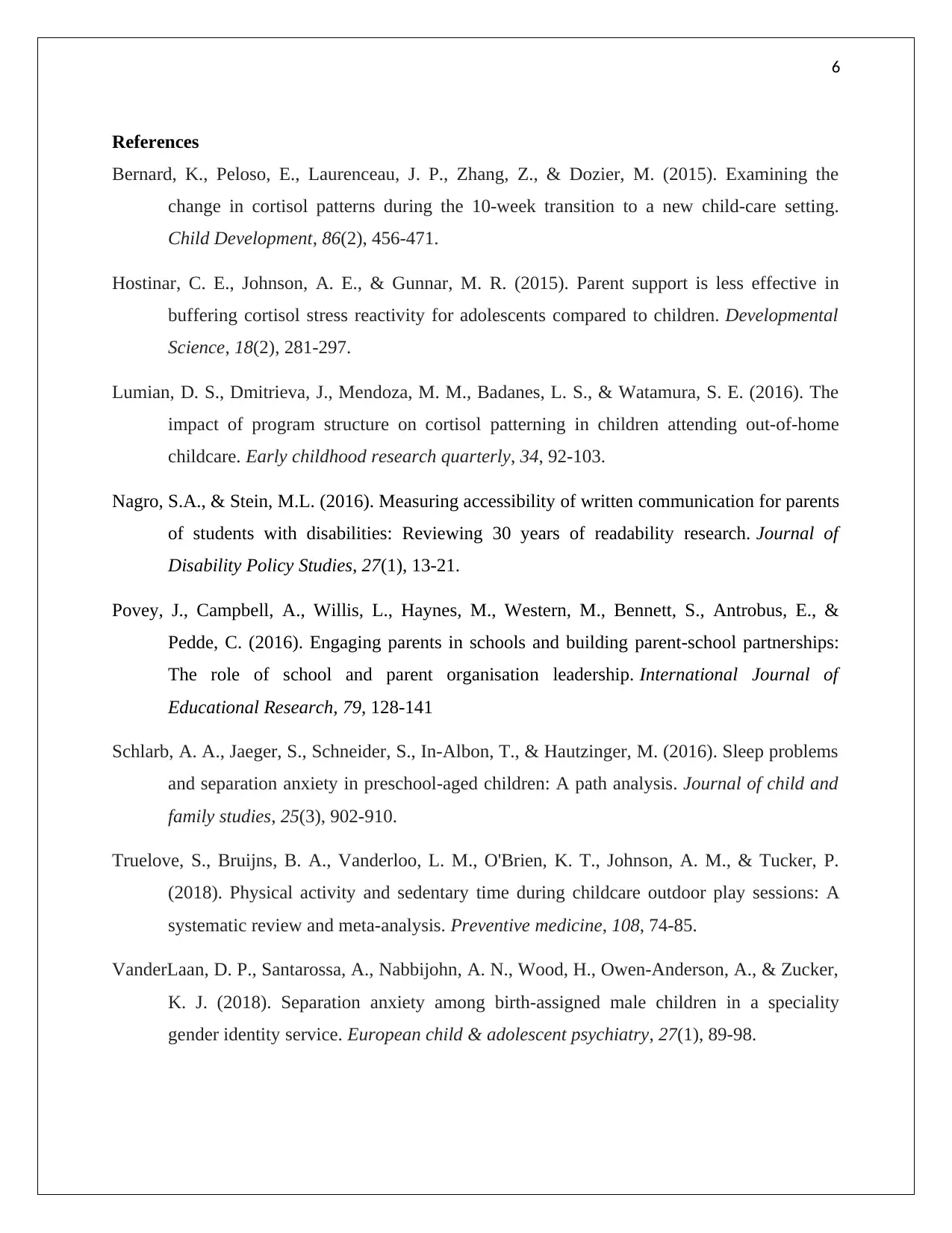Childcare Practices: Supporting Children, Families, and Transitions
VerifiedAdded on 2022/11/17
|7
|1549
|372
Homework Assignment
AI Summary
This assignment delves into various aspects of childcare, focusing on creating supportive environments for children and families. It covers strategies for implementing movement and physical activities, preparing children for changes, and minimizing distress during family separations. The assignment emphasizes the importance of developing meaningful routines, observing signs of stress in both children and parents, and fostering positive communication. Specific examples are provided, such as how to handle bedwetting incidents and create smooth transitions for new arrivals. The responses highlight the caregiver's role in promoting emotional well-being and ensuring children feel safe and secure. The assignment also discusses how to encourage relaxed separations and respond to children's distress with reassurance and calm interactions. The use of communication skills and creating predictable routines are also discussed to ensure smooth transition of new arrivals. Overall, the assignment provides practical guidance for childcare providers to create a nurturing and supportive atmosphere for children and their families.

Healthcare
Student’s Name:
Student’s ID:
Student’s Name:
Student’s ID:
Paraphrase This Document
Need a fresh take? Get an instant paraphrase of this document with our AI Paraphraser

1
Table of Contents
Answer 1......................................................................................................................................................2
Answer 2......................................................................................................................................................2
Answer 3......................................................................................................................................................2
Answer 4......................................................................................................................................................2
Answer 5......................................................................................................................................................3
Answer 6......................................................................................................................................................3
Answer 7......................................................................................................................................................3
Answer 8......................................................................................................................................................4
Answer 9......................................................................................................................................................4
Answer 10....................................................................................................................................................4
Answer 11....................................................................................................................................................4
References...................................................................................................................................................6
Table of Contents
Answer 1......................................................................................................................................................2
Answer 2......................................................................................................................................................2
Answer 3......................................................................................................................................................2
Answer 4......................................................................................................................................................2
Answer 5......................................................................................................................................................3
Answer 6......................................................................................................................................................3
Answer 7......................................................................................................................................................3
Answer 8......................................................................................................................................................4
Answer 9......................................................................................................................................................4
Answer 10....................................................................................................................................................4
Answer 11....................................................................................................................................................4
References...................................................................................................................................................6

2
Answer 1
Movement and physical experiences can be implemented as part of the program for all children
in the following ways:
A large and softball can be used to practice catching, bouncing, kicking and hitting
The children must be involved in games that have various kinds of movement such as getting
the children in chasing bubbles, gathering shells, jumping over the puddles, cracking in the
ground or walking beside the chalk lines (Bernard, Peloso, Laurenceau, Zhang & Dozier,
2015)
Answer 2
The changes faced by the children might be due to the arrival of new children in the center,
leaving of children, changes in care program or changes in rooms, settings and teams (Hostinar,
Johnson & Gunnar, 2015). The children can be prepared for changes in a supportive and timely
manner in the following ways:
The children must be informed of the changes
They should be spoken either individually or in groups
They must be motivated for discussions and questions mainly when the children are to be
involved in planning changes
Answer 3
The following ways can minimize the distress at a separation of the family and child:
The emotional, social and cognitive development of the child must be influenced
The child should be made to feel comfortable and secure
He or she must be made aware of the expectations of the situation
The child should be helped to decrease the frequency of behavior problem
He or she must be engaged in those activities where the caregivers can understand the present
behaviors of the child
Answer 4
As a caregiver of children, I have often observed that the upfront parents express their concerns
for their children and the care given to their children in the center. The reuniting time with their
Answer 1
Movement and physical experiences can be implemented as part of the program for all children
in the following ways:
A large and softball can be used to practice catching, bouncing, kicking and hitting
The children must be involved in games that have various kinds of movement such as getting
the children in chasing bubbles, gathering shells, jumping over the puddles, cracking in the
ground or walking beside the chalk lines (Bernard, Peloso, Laurenceau, Zhang & Dozier,
2015)
Answer 2
The changes faced by the children might be due to the arrival of new children in the center,
leaving of children, changes in care program or changes in rooms, settings and teams (Hostinar,
Johnson & Gunnar, 2015). The children can be prepared for changes in a supportive and timely
manner in the following ways:
The children must be informed of the changes
They should be spoken either individually or in groups
They must be motivated for discussions and questions mainly when the children are to be
involved in planning changes
Answer 3
The following ways can minimize the distress at a separation of the family and child:
The emotional, social and cognitive development of the child must be influenced
The child should be made to feel comfortable and secure
He or she must be made aware of the expectations of the situation
The child should be helped to decrease the frequency of behavior problem
He or she must be engaged in those activities where the caregivers can understand the present
behaviors of the child
Answer 4
As a caregiver of children, I have often observed that the upfront parents express their concerns
for their children and the care given to their children in the center. The reuniting time with their
⊘ This is a preview!⊘
Do you want full access?
Subscribe today to unlock all pages.

Trusted by 1+ million students worldwide

3
child might be only a few hours away, but the parents have mixed emotions for their child since
they gave to deal with daily stresses of life such as work, financial and family pressures (Lumian,
Dmitrieva, Mendoza, Badanes & Watamura, 2016). The children face the stress due to the
rushing of their parents in the morning, interruption in their playing for being dressed or rushing
to daycare.
Answer 5
As soon as the family arrived, I greeted the child and parents by their name, I then started a
three-way interaction where I shared some information about the child with his parents and
simultaneously smiled and made eye-contact with the child. At that time, a transitional object, a
toy was utilized for comforting and calming down the child during our interaction. The child was
to be feel welcoming in the situation while we were interacting.
Answer 6
The family can be encouraged to have relaxed and unhurried separation from their child in the
following ways:
The parents must be motivated to spend more time with the child in the center. It can help
them to get more information about their children, their specific needs, rhythms and routines
(Nagro & Stein, 2016)
Unhurried separation can ensure the parents that they have selected the correct center and
caregiver for their child and that their child is receiving the best attention and care
(VanderLaan et al., 2018)
The motivation to the parents to have unhurried separation can make them involved with
their child’s care regularly
Answer 7
The strategies to respond to the distress of the children between two to five years at departure
from the family calmly and reassuringly are as follows:
The parents must be motivated to have a predictable routine in the morning before the child
enters the center
There should be anticipated arrival and personalized goodbye routine for the children (Povey
et al., 2016)
child might be only a few hours away, but the parents have mixed emotions for their child since
they gave to deal with daily stresses of life such as work, financial and family pressures (Lumian,
Dmitrieva, Mendoza, Badanes & Watamura, 2016). The children face the stress due to the
rushing of their parents in the morning, interruption in their playing for being dressed or rushing
to daycare.
Answer 5
As soon as the family arrived, I greeted the child and parents by their name, I then started a
three-way interaction where I shared some information about the child with his parents and
simultaneously smiled and made eye-contact with the child. At that time, a transitional object, a
toy was utilized for comforting and calming down the child during our interaction. The child was
to be feel welcoming in the situation while we were interacting.
Answer 6
The family can be encouraged to have relaxed and unhurried separation from their child in the
following ways:
The parents must be motivated to spend more time with the child in the center. It can help
them to get more information about their children, their specific needs, rhythms and routines
(Nagro & Stein, 2016)
Unhurried separation can ensure the parents that they have selected the correct center and
caregiver for their child and that their child is receiving the best attention and care
(VanderLaan et al., 2018)
The motivation to the parents to have unhurried separation can make them involved with
their child’s care regularly
Answer 7
The strategies to respond to the distress of the children between two to five years at departure
from the family calmly and reassuringly are as follows:
The parents must be motivated to have a predictable routine in the morning before the child
enters the center
There should be anticipated arrival and personalized goodbye routine for the children (Povey
et al., 2016)
Paraphrase This Document
Need a fresh take? Get an instant paraphrase of this document with our AI Paraphraser

4
The children must be encouraged to bring a comforter, a family photo or a security toy from
home that can make them feel an emotional connection
Answer 8
Being a childcare provider, I always use my oral communication skills to interact positively and
calmly with families and children. Once a family was rude to me as they were concerned about
their child. But my positive and calm interaction made the family feel that their children are safe
with me. The children also felt free to play, explore as well as learn in the center.
Answer 9
The following strategies can ensure the smooth transition of new arrivals:
The new arrivals must not be assumed that they know what is expected. The childcare
provider should be patient with the new children in the center
Since the transition times are hectic, so the childcare provider must plan much before the
transition time and make every material handy (Schlarb, Jaeger, Schneider, In-Albon &
Hautzinger, 2016)
The childcare provider must know the likes and dislikes of the new arrivals as well what
works and what does not for the new children
Answer 10
The following strategies can help to support children through transition and changes:
The children should be given sufficient time for preparing for the changes and transition and
make them feel that they have some control in their day and their situations
Some of the children might not comprehend changes and transition and the multiple
directions that are given to them at a time (Truelove et al., 2018). Those children must be
pointed out and comforted next time
Answer 11
When a child wets his bed at night, he was cleaned by me, the bedsheets were changed, and he
was put back to his bed.
1. Another child wetted his pant; I followed the following steps:
I assured the child that accidents can take place anytime, and it is okay
The children must be encouraged to bring a comforter, a family photo or a security toy from
home that can make them feel an emotional connection
Answer 8
Being a childcare provider, I always use my oral communication skills to interact positively and
calmly with families and children. Once a family was rude to me as they were concerned about
their child. But my positive and calm interaction made the family feel that their children are safe
with me. The children also felt free to play, explore as well as learn in the center.
Answer 9
The following strategies can ensure the smooth transition of new arrivals:
The new arrivals must not be assumed that they know what is expected. The childcare
provider should be patient with the new children in the center
Since the transition times are hectic, so the childcare provider must plan much before the
transition time and make every material handy (Schlarb, Jaeger, Schneider, In-Albon &
Hautzinger, 2016)
The childcare provider must know the likes and dislikes of the new arrivals as well what
works and what does not for the new children
Answer 10
The following strategies can help to support children through transition and changes:
The children should be given sufficient time for preparing for the changes and transition and
make them feel that they have some control in their day and their situations
Some of the children might not comprehend changes and transition and the multiple
directions that are given to them at a time (Truelove et al., 2018). Those children must be
pointed out and comforted next time
Answer 11
When a child wets his bed at night, he was cleaned by me, the bedsheets were changed, and he
was put back to his bed.
1. Another child wetted his pant; I followed the following steps:
I assured the child that accidents can take place anytime, and it is okay

5
I put on my gloves and helped the child to remove his pants. He was provided with wipes
assist in cleaning himself
I sealed his clothes in a plastic bag, labelled with his name and sent home to his family on
pickup
Finally, I removed my gloves, redressed the child and reminded him to tell if he needs to go
for toilet
I put on my gloves and helped the child to remove his pants. He was provided with wipes
assist in cleaning himself
I sealed his clothes in a plastic bag, labelled with his name and sent home to his family on
pickup
Finally, I removed my gloves, redressed the child and reminded him to tell if he needs to go
for toilet
⊘ This is a preview!⊘
Do you want full access?
Subscribe today to unlock all pages.

Trusted by 1+ million students worldwide

6
References
Bernard, K., Peloso, E., Laurenceau, J. P., Zhang, Z., & Dozier, M. (2015). Examining the
change in cortisol patterns during the 10‐week transition to a new child‐care setting.
Child Development, 86(2), 456-471.
Hostinar, C. E., Johnson, A. E., & Gunnar, M. R. (2015). Parent support is less effective in
buffering cortisol stress reactivity for adolescents compared to children. Developmental
Science, 18(2), 281-297.
Lumian, D. S., Dmitrieva, J., Mendoza, M. M., Badanes, L. S., & Watamura, S. E. (2016). The
impact of program structure on cortisol patterning in children attending out-of-home
childcare. Early childhood research quarterly, 34, 92-103.
Nagro, S.A., & Stein, M.L. (2016). Measuring accessibility of written communication for parents
of students with disabilities: Reviewing 30 years of readability research. Journal of
Disability Policy Studies, 27(1), 13-21.
Povey, J., Campbell, A., Willis, L., Haynes, M., Western, M., Bennett, S., Antrobus, E., &
Pedde, C. (2016). Engaging parents in schools and building parent-school partnerships:
The role of school and parent organisation leadership. International Journal of
Educational Research, 79, 128-141
Schlarb, A. A., Jaeger, S., Schneider, S., In-Albon, T., & Hautzinger, M. (2016). Sleep problems
and separation anxiety in preschool-aged children: A path analysis. Journal of child and
family studies, 25(3), 902-910.
Truelove, S., Bruijns, B. A., Vanderloo, L. M., O'Brien, K. T., Johnson, A. M., & Tucker, P.
(2018). Physical activity and sedentary time during childcare outdoor play sessions: A
systematic review and meta-analysis. Preventive medicine, 108, 74-85.
VanderLaan, D. P., Santarossa, A., Nabbijohn, A. N., Wood, H., Owen-Anderson, A., & Zucker,
K. J. (2018). Separation anxiety among birth-assigned male children in a speciality
gender identity service. European child & adolescent psychiatry, 27(1), 89-98.
References
Bernard, K., Peloso, E., Laurenceau, J. P., Zhang, Z., & Dozier, M. (2015). Examining the
change in cortisol patterns during the 10‐week transition to a new child‐care setting.
Child Development, 86(2), 456-471.
Hostinar, C. E., Johnson, A. E., & Gunnar, M. R. (2015). Parent support is less effective in
buffering cortisol stress reactivity for adolescents compared to children. Developmental
Science, 18(2), 281-297.
Lumian, D. S., Dmitrieva, J., Mendoza, M. M., Badanes, L. S., & Watamura, S. E. (2016). The
impact of program structure on cortisol patterning in children attending out-of-home
childcare. Early childhood research quarterly, 34, 92-103.
Nagro, S.A., & Stein, M.L. (2016). Measuring accessibility of written communication for parents
of students with disabilities: Reviewing 30 years of readability research. Journal of
Disability Policy Studies, 27(1), 13-21.
Povey, J., Campbell, A., Willis, L., Haynes, M., Western, M., Bennett, S., Antrobus, E., &
Pedde, C. (2016). Engaging parents in schools and building parent-school partnerships:
The role of school and parent organisation leadership. International Journal of
Educational Research, 79, 128-141
Schlarb, A. A., Jaeger, S., Schneider, S., In-Albon, T., & Hautzinger, M. (2016). Sleep problems
and separation anxiety in preschool-aged children: A path analysis. Journal of child and
family studies, 25(3), 902-910.
Truelove, S., Bruijns, B. A., Vanderloo, L. M., O'Brien, K. T., Johnson, A. M., & Tucker, P.
(2018). Physical activity and sedentary time during childcare outdoor play sessions: A
systematic review and meta-analysis. Preventive medicine, 108, 74-85.
VanderLaan, D. P., Santarossa, A., Nabbijohn, A. N., Wood, H., Owen-Anderson, A., & Zucker,
K. J. (2018). Separation anxiety among birth-assigned male children in a speciality
gender identity service. European child & adolescent psychiatry, 27(1), 89-98.
1 out of 7
Related Documents
Your All-in-One AI-Powered Toolkit for Academic Success.
+13062052269
info@desklib.com
Available 24*7 on WhatsApp / Email
![[object Object]](/_next/static/media/star-bottom.7253800d.svg)
Unlock your academic potential
Copyright © 2020–2025 A2Z Services. All Rights Reserved. Developed and managed by ZUCOL.





